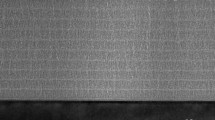Abstract
Si quantum dots (Si QDs)/SiC multilayers were fabricated by annealing hydrogenated amorphous Si/SiC stacked structures prepared in plasma enhanced chemical vapor deposition (PECVD) system. The microstructures were examined by transmission electron microscopy (TEM) and Raman spectroscopy, and results demonstrate the formation of Si QDs. Moreover, p-i-n devices containing Si QDs/SiC multilayers were fabricated, and their photovoltaic property was investigated. It was found that these devices show the good spectral response in a wide wavelength range (400–1200 nm). And it was also observed that by reducing the thickness of SiC layer from 4 to 2 nm, the external quantum efficiency was obviously enhanced and the short circuit current density (J sc) was increased from 17.5 to 28.3 mA/cm2, indicating the collection efficiency of photo-generated carriers was improved due to the reduced SiC barriers.
Similar content being viewed by others
References
Surana K, Lepage H, Lebrun J M, Doisneau B, Bellet D, Vandroux L, Le Carval G, Baudrit M, Thony P, Mur P. Film-thickness-dependent conduction in ordered Si quantum dot arrays. Nanotechnology, 2012, 23(10): 105401–105410
Kurokawa Y, Tomita S, Miyajima S, Yamada A, Konagai M. Photoluminescence from silicon quantum dots in Si quantum dots/amorphous SiC superlattice. Japanese Journal of Applied Physics, 2007, 46(35): L833–L835
Baron T, Gentile P, Magnea N, Mur P. Single-electron charging effect in individual Si nanocrystals. Applied Physics Letters, 2001, 79(8): 1175–1177
Conibeer G, Green M A, Corkish R, Cho Y, Cho E C, Jiang C W, Fangsuwannarak T, Pink E, Huang Y D, Puzzer T, Trupke T, Richards B, Shalav A, Lind K L. Silicon nanostructures for third generation photovoltaic solar cells. Thin Solid Films, 2006, 26(511–512): 654–662
Perez-Wurfl I, Ma L, Lin D, Hao X, Green MA, Conibeer G. Silicon nanocrystals in an oxide matrix for thin film solar cells with 492 mV open circuit voltage. Solar Energy Materials and Solar Cells, 2012, 100: 65–68
Uchida G, Yamamoto K, Sato M, Kawashima Y, Nakahara K, Kamataki K, Itagaki N, Koga K, Shiratani M. Effect of nitridation of Si nanoparticles on the performance of quantum-dot sensitized solar cells. Japanese Journal of Applied Physics, 2012, 51(1): 01AD01–01AD01-5
Conibeer G, Green M A, König D, Perez-Wurfl I, Huang S J, Hao X J, Di D W, Shi L, Shrestha S, Puthen-Veetil B, So Y, Zhang B, Wan Z Y. Silicon quantum dot based solar cells: addressing the issues of doping, voltage and current transport. Progress in Photovoltaics: Research and Applications, 2010, 7(19): 813–824
Creazzo T, Redding B, Marchena E, Murakowski J, Prather D W. Tunable photoluminescence and electroluminescence of size-controlled silicon nanocrystals in nanocrystalline-Si/SiO2 superlattices. Journal of Luminescence, 2010, 130(4): 631–636
Cho E C, Park S W, Hao X J, Song D Y, Conibeer G, Park S C, Green M A. Silicon quantum dot/crystalline silicon solar cells. Nanotechnology, 2008, 19(24): 245201–245205
Pi X D, Zhang L, Yang D R. Enhanced the efficiency of multicrystalline silicon solar cells by the inkjet printing of silicon-quantum-dot ink. Journal of Physical Chemistry C, 2012, 116(40): 21240–21243
Jiang CW, Green MA. Silicon quantum dot superlattices: modeling of energy bands, densities of states, and mobilities for silicon tandem solar cell applications. Journal of Applied Physics, 2006, 99(11): 114902–114908
Rui Y J, Li S X, Xu J, Song C, Jiang X F, Li W, Chen K J, Wang Q M, Zuo Y H. Size-dependent electroluminescence from Si quantum dots embedded in amorphous SiC matrix. Journal of Applied Physics, 2011, 110(6): 064322–064327
Li S X, Rui Y J, Cao Y Q, Xu J, Chen K J. Annealing effect on optical and electronic properties of silicon rich amorphous silicon-carbide films. Front. Optoelectron, 2012, 5(1): 107–111
Tsu R, Gonzalez - Hernandez J, ChaoS S, Lee S C, Tanaka K. Critical volume fraction of crystallinity for conductivity percolation in phosphorus-doped Si:F:H alloys. Applied Physics Letters, 1982, 40(6): 534–535
Zhou J, Chen G R, Liu Y, Xu J, Wang T, Wan N, Ma Z Y, Li W, Song C, Chen K J. Electroluminescent devices based on amorphous SiN/Si quantum dots/amorphous SiN sandwiched structures. Optics Express, 2009, 17(1): 156–162
Rui Y J, Li S X, Xu J, Cao Y Q, Li W, Chen K J. Comparative study of electroluminescence from annealed amorphous SiC single layer and amorphous Si/SiC multilayers. Journal of Non-Crystalline Solids, 2012, 358(17): 2114–2117
Budiman M F, Hu W, Igarashi M, Tsukamoto R, Isoda T, Itoh K M, Yamashita I, Murayama A, Okada Y, Samukawa S. Control of optical bandgap energy and optical absorption coefficient by geometric parameters in sub-10 nm silicon-nanodisc array structure. Nanotechnology, 2012, 23(6): 065302–065307
Chiu PW, Roth S. Transition from direct tunneling to field emission in carbon nanotube intramolecular junctions. Applied Physics Letters, 2008, 92(4): 042107-3
Wang Q. High-efficiency hydrogenated amorphous/crystalline Si heterojunction solar cells. Philosophical Magazine, 2009, 89(28): 2587–2598
Taguchi M, Maruyama E, Tanaka M. Temperature dependence of amorphous/crystalline silicon heterojunction solar cells. Japanese Journal of Applied Physics, 2008, 47(2): 814–818
Author information
Authors and Affiliations
Corresponding author
Rights and permissions
About this article
Cite this article
Cao, YQ., Xu, X., Li, SX. et al. Improved photovoltaic properties of Si quantum dots/SiC multilayers-based heterojunction solar cells by reducing tunneling barrier thickness. Front. Optoelectron. 6, 228–233 (2013). https://doi.org/10.1007/s12200-013-0324-z
Received:
Accepted:
Published:
Issue Date:
DOI: https://doi.org/10.1007/s12200-013-0324-z




